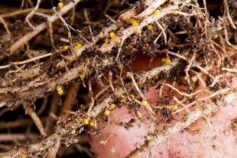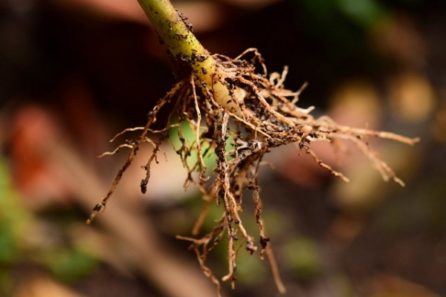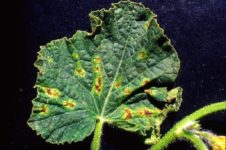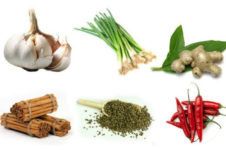Nematodes are a real threat to the crop. They are small, so it's hard to notice them. They can affect any part of plants, there are leaf, stem and root. Some species live in the soil, which complicates the process of getting rid of parasites. Gardeners need to know the signs of plant damage and pest control methods.
Material Content:
Nematodes - what is it in crop production?
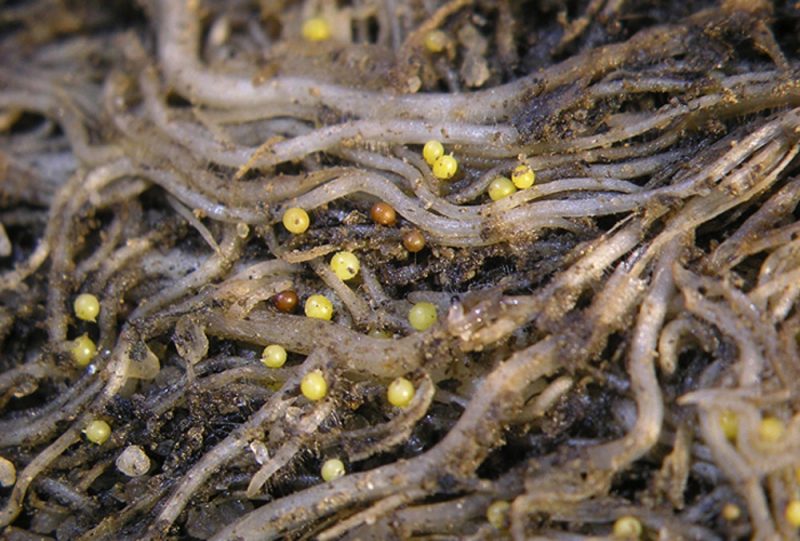
These are round worms, no larger than 2 mm in size. They settle in the soil and aboveground parts of plants. The roots, leaves, flowers, stems and seeds are affected. The plant slows down in growth and dies.
Important. Nematodes affect garden, vegetable and indoor plants.
A variety of nematodes
There are many varieties of nematodes, but 3 groups bring the greatest damage:
• leafy;
• stem;
• root.
They differ in that they affect different parts of the plant.
Leafy
The size of the parasites does not exceed 1 mm. They move quickly, so it's hard to notice.
Symptoms of defeat by this type of nematodes:
• deformation and thinning of the sheet plate;
• the appearance of yellow, and then brown spots on the leaves;
• discolored transparent patches on a sheet plate.
Not only the leaves dry, but also the plant.
Most often, a leaf nematode appears on strawberries, strawberries and chrysanthemums.
Parasites live in flowers and on leaves, feed on plant sap, and also carry viral and fungal diseases. They rarely move to the ground, in winter they hide in dry foliage.
Stem
The size of this variety of pests also does not exceed 1-1.5 mm. They can parasitize not only on the stems, but also on the flowers and leaves. Often hit flowers and vegetable plants. The most favorite are tomatoes, cucumbers, radishes, onions, garlic, parsley, as well as tulips, cloves, begonias.
Symptoms of defeat:
• shoots stop growing;
• stems thicken, swell in some places;
• shoots become pale in color, turn brown;
• stems, leaves and flowers become unnatural in shape and color.
Root
The second name of this group is gall. Females are smaller (up to 1 mm), males up to 2 mm long.
Parasites settle in galls - tubercles on the roots. Females lay eggs, from which larvae then emerge. Young individuals actively suck juice from the roots. Development is from 19 to 45 days. Adult females remain in galls, while males seek new food.
Symptoms of infection:
• slowing plant growth;
• curl of leaves;
• the formation of tubercles and swelling on the roots.
At first, the galls have a yellow tint, but eventually become dark brown. More often, it is not possible to save the plant.
Nematodes in the soil actively grow and multiply under such conditions:
• air temperature 18-24˚С;
• moderate soil moisture in the range of 40-60%;
• soil pH 5.5-5.8.
What does the affected plant look like
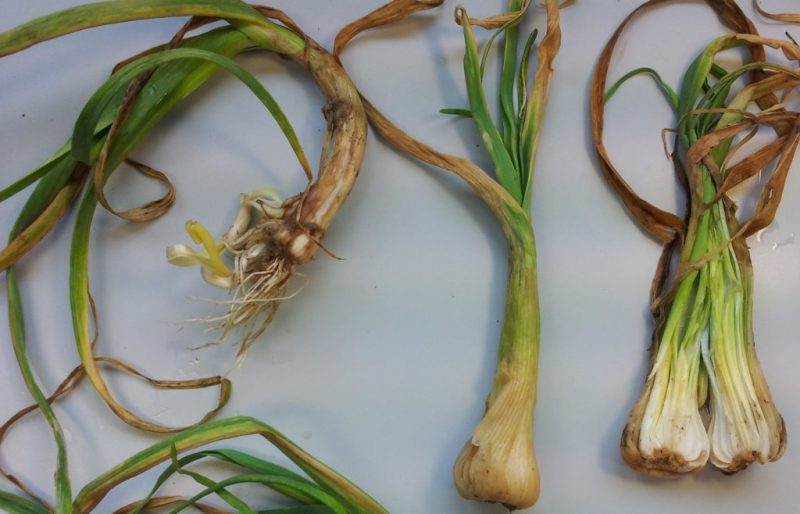
It is very difficult to guess the existence of parasites because of their small size. A nematode can be considered only if you carefully look. More often they are found at the moment when the plant can no longer be saved. Damage is caused not only by adults, but also by larvae.
Signs of culture damage by nematodes:
• slowdown of growth and development (internodes are shortened, leaf petioles are thickened);
• weak flowering;
• drying of leaves;
• curvature and deformation of the stem;
• drying out of the kidneys;
• excessive branching of the root system;
• rotting of small roots, the formation of galls and ulcers;
• extensive dying of the root system.
If the larvae live in the soil, then the seeds may not germinate, shoots appear later.
Important. Nematodes pierce plant tissue, resulting in a favorable environment for the propagation of fungi and viruses.
Nematode Control Measures
Go to action is necessary at the first sign of infection with nematodes. Parasites actively reproduce, up to 6 generations per season. If you do not react on time, you can lose the entire crop.
Chemicals are most effective, but due to their high toxicity, it is not always advisable to use them. Sometimes it is better to resort to folk methods.
Important. During the fight against the nematode, it is necessary to process garden tools, clothes and shoes, since eggs can be on them. It is enough to carry out heat treatment, spraying with a disinfectant solution "Lysol" or "Formalin".
Chemical reagents against nematodes
Even if there are isolated cases of damage to plants, the removal and burning of an infected crop is not enough. Nematodes can be in the soil or on the roots, and symptoms of the lesion will appear after a while.
In the fight against these parasites, you need to be patient, because even the most powerful chemicals are not able to remove eggs and larvae at a time. The first to die are adults.
It will take 3-4 procedures. The processing interval is 10-14 days.
Nematocides are used to combat nematodes. Popular chemicals:
• "Phosphamide";
• "Mercaptophos";
• “Lindane”;
• Bazamide;
• "Carbation";
• "Vidat";
• Nemaphos;
• "Nemagon";
• “Heterophos”.
All chemicals are highly toxic, therefore, it is necessary to use personal protective equipment - a mask, gloves, rubber boots, etc. Processing cannot be carried out in greenhouses or the enclosed space.
Each agent has its own treatment scheme, so before using the chemical, you must read the instructions.
Fighting folk remedies
How to deal with the land nematode? Suitable biological products. They can be used even in greenhouses. Effective drug "Basamil KS." They need to spill the soil 3-4 times with an interval of 5-7 days.
You can destroy adults, larvae and eggs with the help of a hot shower. It is necessary to water the plants and the soil for 30 minutes with water at a temperature of 40-45 ° C. Bulbs of horticultural crops need to be dug up and placed in hot water (45-48 ° C) for 15 minutes.
Marigolds, calendula, peas, beans and soy are scared away by nematodes. These plants need to be planted around greenhouses or along vegetable rows.
Effective with nematodes such means:
• Infusion of calendula. 1 tbsp. l dry herbs need to pour 1 liter of boiling water, leave for a day. Ready infusion water the soil and the plants themselves 2 times a month. Infusion is also suitable for the prevention of pests.
• A solution of tablets "Dekaris". In 1 liter of water you need to dissolve 1 tablet. Ready solution to water the plants and soil. Enough 3-4 treatments with an interval of 10-14 days.
Folk remedies scare off parasites and reduce their numbers. With extensive damage, resort to more effective methods, for example, treatment with chemicals.
How to deal with a nematode on different plants
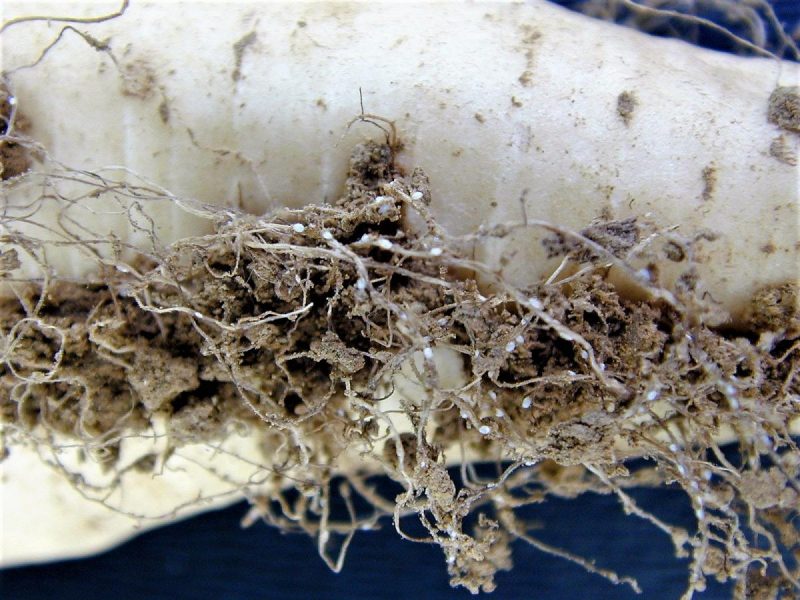
The choice of an effective technique depends on which parts of the plants the pest infects. The most difficult to fight with root varieties.
Strawberry Nematode
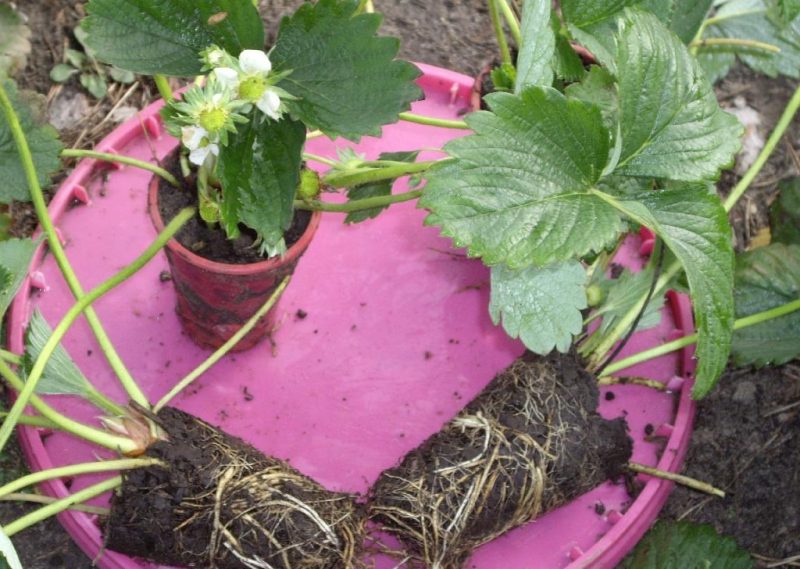
In early spring, when the first leaves appear, it is necessary to spray strawberries with Bordeaux liquid or vitriol. During the growing season 4 times with an interval of 3-5 days, you can treat the plants with "Phosphamide" or "Markaptofos".
After harvesting, you need to water the bushes with a solution of “Skor” or “Fundazol”. It is necessary to plant marigolds or marigolds around a strawberry plantation, remove diseased bushes. Dig grooves along the rows into which to pour lime.
Golden Potato Nematode

Golden potato nematode belongs to the group of root nematodes. The parasite infects potato tubers.
Chemicals are inappropriate to use, as potatoes will be unusable. The main method of getting rid of the nematode is to reduce its number, as well as planting potato varieties resistant to this parasite.
Effective folk remedies:
• Making a large amount of bird droppings.
• Use infusion of potato sprouts. It must be poured into the ground when there are no other crops on the site. This stimulates the release of larvae from eggs that die within 30-40 days due to lack of food.
Onion nematode
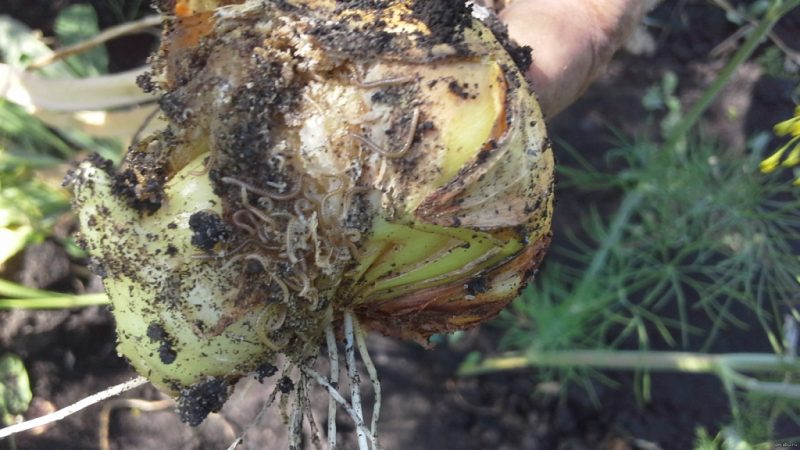
Onion nematode parasitizes onions, onion flowers, potatoes, tomatoes and other vegetable crops. Often the source of infection is planting material, so the bulbs must be kept in hot water at a temperature of up to 50 ° C before planting, and then dried well.
5-10 days before planting, you need to sprinkle on the site "Percalcite" or 30 days before the start of sowing - "Carbamide". You can spill the beds with ammonia water.
Prevention
Root nematodes can get to the site along with garden or forest soil, compost, humus and other types of fertilizers. To avoid infection, it is necessary to disinfect, or till the ground.
There are 3 types of processing - calcine the soil in the oven for 1.5-2 hours at a temperature of 100 ° C, steam sterilize for 30 minutes. or pour boiling water.
Other preventative measures:
• You can not use the infected plant for propagation, it must be immediately removed from the garden and burned. Pour boiling water over the soil where it grew.
• For planting, buy only healthy planting material. Before planting, you must carefully inspect the root system, soak the roots for 10-15 minutes.in a solution of Parathion or Fosdrin.
• It is better to carry out spraying and watering no later than 6 pm, so that the leaves and the soil have time to dry out a little. Nematodes love moist soil, so moisture stagnation should not be allowed.
• Properly organize crop rotation. Nematodes feed on only one type of plant. If the next year to plant another type of vegetable crop, then the parasites will have nothing to eat, and they will die. But you need to remember that the larvae remain viable for a long period, so infected plants can not be planted for 3-4 years.
It is important to properly care for garden crops so that they grow strong, apply mineral and organic fertilizers on time, loosen the soil and remove weeds.



